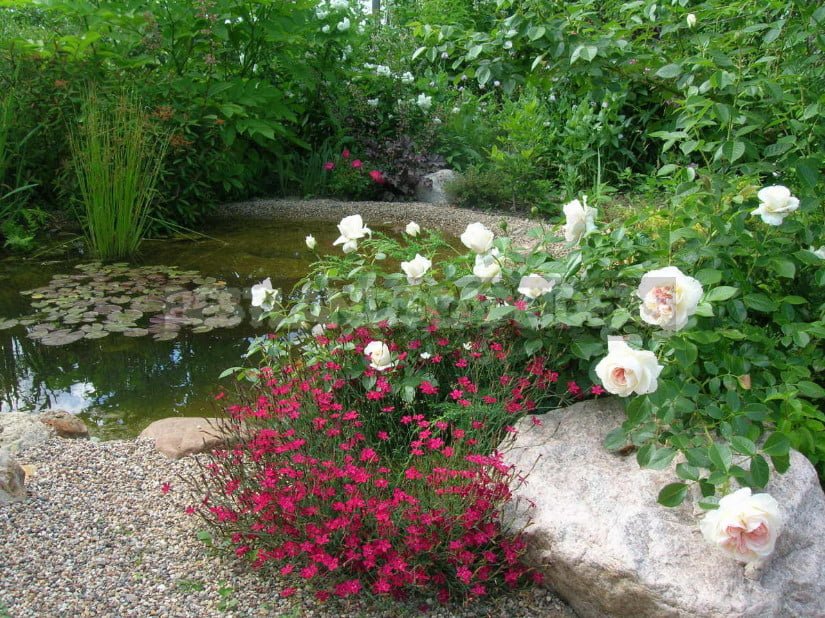
The style of design of a garden pond and the complexity of its maintenance directly depend on what kind of water device you eventually preferred, in what environment it was entered and what manufacturing technology you chose. I would like to talk in more detail about water and coastal plants, their role in the ability of the reservoir to exist in an Autonomous mode and simple operations, without which it will not be possible.
A few General rules
The design of the garden pond water and coastal plants has its own specifics. On the one hand, all of them should be decorative and interesting from spring to late autumn, while not to cause trouble in the care, fit well into the composition with the surrounding garden plants and match the size of the pond. On the other hand, the plants that we will put into the pond should perform quite practical tasks – to purify the water, absorbing the excess dissolved organic matter, saturate it with oxygen, serve as food and shelter for the inhabitants of the water area.
The plants must always comply with the pond in style, be consistent with the General plan and not contrary to common sense. For example, cacti and succulents, steppe and semi-desert cereals in nature do not grow on the banks of reservoirs, so some plants look next to the water, as sewn with white thread. However, classical garden plants, including roses, are quite appropriate on the shore of the landscape garden pond, if they are organically inscribed in the overall composition, do not suppress the surrounding “simple” plants and, most importantly, do not violate the inherent water element harmonious restraint in colors.
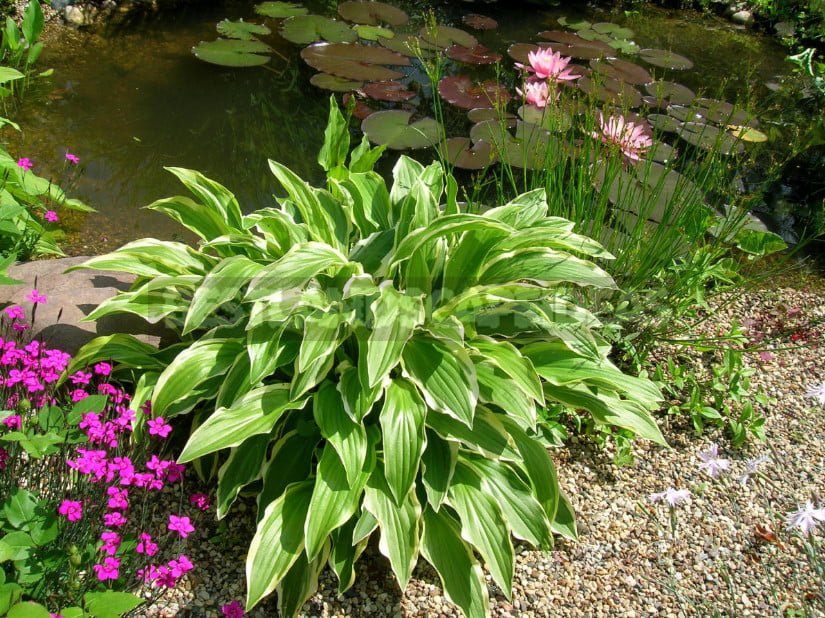
Often there is a situation when the pond is made perfectly, effectively inscribed in the General outline, and there is no harmony. This happens when we do not think about what to plant directly in the water and how to place certain plants near the pond or stream. Too large curtain on the shore or ill-conceived planting near the pond can visually reduce its size. Conversely, medium-sized, with thin leaves, gracefully curved coastal plants, with the knowledge of the chosen water lilies favorably emphasize the smooth lines of the shore, without unnecessarily closing the water surface.
Therefore, first, it is necessary to take into account the degree of growth of plants. Second, determine the focal points. If the Aqua garden has one side of the view, the largest, cool plants are located on the opposite side. And if the pond should be clearly visible from all sides, it is necessary to distribute the plants in groups, leaving a sufficient part of the coastline open, only filling it with gravel or tightening very low, creeping plants.
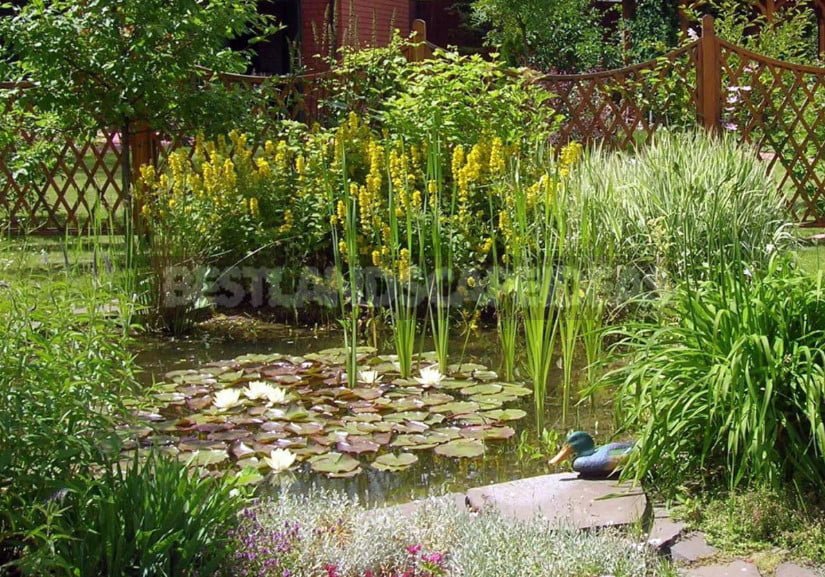
Using for planting aquatic plants special mesh or any other plastic containers, we often completely forget that in the water they are usually very clearly visible. Plastic, translucent from the depths, of course, spoils the overall impression. Therefore, if you use containers for planting aquatic plants, take care to further decorate them with soil, sand, gravel or pebbles in accordance with the overall style of design.
Do not forget that aquatic plants develop very quickly, especially in limited container conditions. You will have quite often — not less than 2-3 years-completely remove them from the bottom and terraces to divide and transplant plants.

This is absolutely unnecessary trouble, so it is better to make a bigger pond and plant plants directly into the ground, poured on top of waterproofing. It is advisable to use containers only for planting dwarf water lilies, which should grow at a depth of only 20-40 cm, where it is risky to leave them for the winter, or when decorating a mini-pond in a raised bowl. With the onset of stable cold weather capacity with dwarf and thermophilic plants will have to raise from the water and distribute for the winter: something in the cellar, something to a greater depth in a deeper pond, something to dig in the garden beds. But in most cases there is no need to cultivate aquatic plants in containers. Don’t make your life difficult.
Choose plants
If the garden pond is not very large, the area of its mirror is small, try to use for planting not species plants, and varieties and garden forms. As a rule, they are not only more interesting, but also much less tall and aggressive than their natural counterparts. For example, Typha latifolia in nature perfectly consolidates the coastline and purifies the water, but for the garden pond is too large, so try to purchase T. minima, T. angustifolia or T. gracelis instead.
Iris pseudacorus is also not suitable for every garden pond-it is very large curtain he develops, and its varieties, such as: ‘Variegata’, ‘English Cream’ and ‘Kentucky Moonbeam’ not only decorate and diversify the water decor, but will not take up too much space.
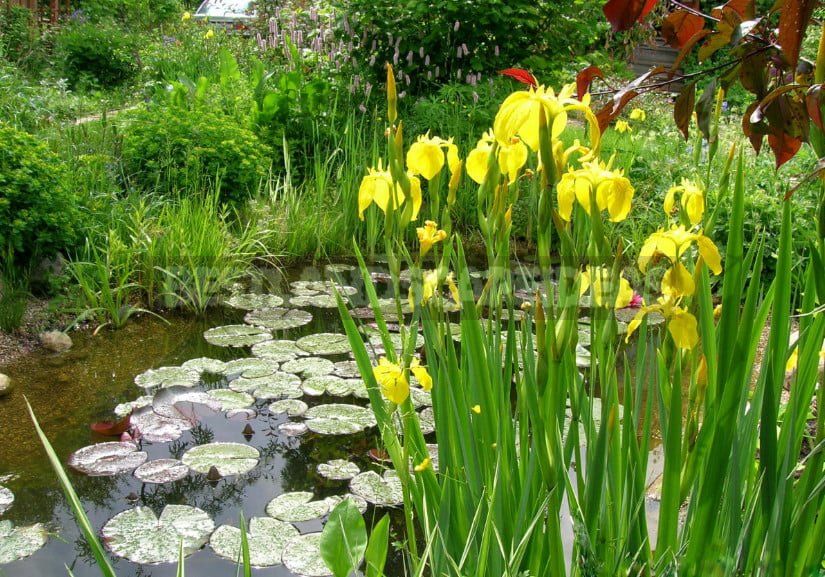
Look great in the water and in shallow water all moisture-loving herbs-first of all, Carex. For landing on small depth suitable varieties of Carex elata ‘Aurea’, C. riparia and its varieties, C. muskingumensis and its varieties, C. panacea, and many others.
To date, there is no problem with the choice. Specialized firms deliver from the European nurseries very various and, it is possible to tell safely, the rich range of water plants. Something can be purchased from collectors, something to find in nature. Do not plant too much, keep yourself in hand, otherwise it may happen that in a couple of years from the water will be one memory. But for the normal life of the entire water community it is absolutely necessary that at least 40% of the water mirror be free from shading – sunlight must penetrate into the water column.

Many plants that occur in nature in wet and even waterlogged places, along the banks of rivers, streams and dams, in the middle band in the warm season may well exist when immersed in water to a depth of 5-20 cm, but winter will be better on dry soils. This must be taken into account when choosing plants for decorating the coastal zone.
For example, varieties Miscanthus sinensis – exquisite decoration of the shore of the garden pond. However, in the middle band Miscanthus sinensis, preferring sufficient soil moisture in the summer, it does not tolerate flooding in the winter. Therefore, its varieties are planted so that the Bush is visually read in the structure of the water garden, but located in loose and nutritious soil outside the pond. Today on sale you can find varieties of different flowering period and different heights: from 60 cm to 2.5 m.
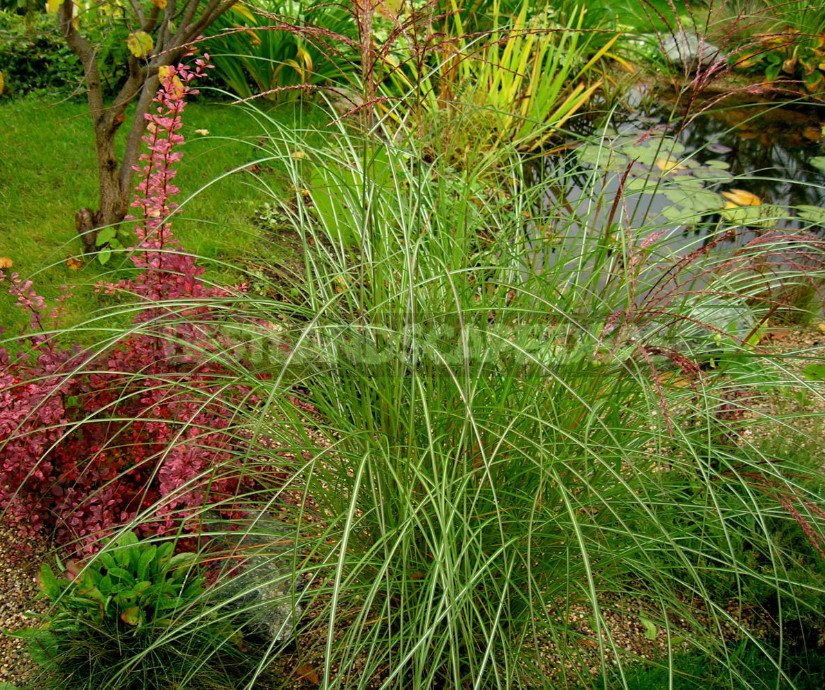
And of course, decorating a water garden is unthinkable without water lilies. Water lilies-Nymphaea -beautiful water creatures. Varieties of cold-resistant water lilies vary in size and color, the degree of double and aroma of flowers, the shape and color of the leaves.
All water lilies are divided into two groups: small and dwarf belong to group n, medium – to group m, large – to group t. Representatives of different groups need to land at different depths. Small and dwarfs will best develop at a depth of 20-40 cm, medium – 60-80 cm, and large for the normal development requires a depth of at least 80-100 cm of the same varieties to successfully adapt, it winters and blooms profusely when submerged to a depth of 60-80 cm, But not to plant dwarfs deeper than 40 cm – they simply will not survive. And the large lilies on the lack of depth will be too rapidly to vegetate at the expense of flowering and quickly “used up”.

Varietal nymph is not able to properly vegetate and blossom at a depth of 1.5 m. In such circumstances, they will be very slow to develop gradually and may die. Unassuming in this regard, natural species such as Nymphaea alba and N. odorata. They grow equally well, bloom and winter at a depth of 40 cm and 2 m. However, they have a significant disadvantage compared to varieties – they bloom not so long and, as a rule, in the middle of summer. For comparison: varietal water lilies bloom usually in the second half of may and bloom to stable cold weather-depending on the weather – until September-October.

All cold-resistant water lilies are absolutely stable and winter-hardy in the middle band, which can not be said about the varieties of water lilies, in the pedigree of which a lot of tropical blood. They can be distinguished from cold-resistant by a number of features: stellate flowers with a pronounced crown of stamens, highly raised above the water surface on strong stems (often blue and purple color), and leaves with a strongly indented edge. Not suitable for planting in temperate zone and Nelumbo nucifera. Even if you keep it in the winter in a non-freezing room, in the summer it still will not bloom fully, we just do not have enough light and heat.
For care of a reservoir and water plants it is necessary to have special pond scissors or a pruner, tongs and a net on long, often retractable, bars. Leaves, losing turgor and starting to turn yellow and boil, you must carefully cut 20-30 cm below the surface of the water and clean up outside the pond.
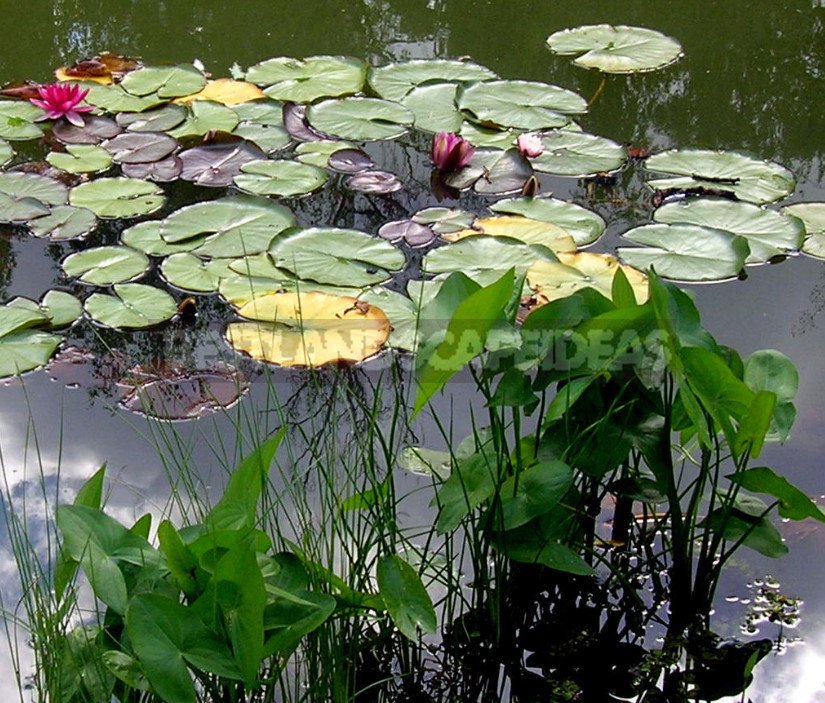
In the spring, when the trees bloom, pollen and dry scales of faded earrings are collected on the water mirror dense layer, preventing the flow of water into the water column of oxygen and sunlight. This garbage, as well as the autumn leaves falling down from trees, it is necessary to collect a net. The more compact the pond, the more carefully have to ensure that as little debris deposited on the bottom.
Shallow-water plants such as Juncus effuses, Scirpus lacustris and Schoenoplectus tabernaemontani ‘Albescens’, and ‘Zebrinus’ to cut for the winter is not worth it. Their dried-up hollow stems not only decorate snow-covered reservoirs in the winter, through them air, so, and oxygen gets under ice. They need to be cut in the spring, when the water melts completely.

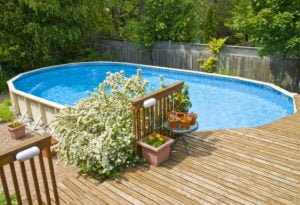
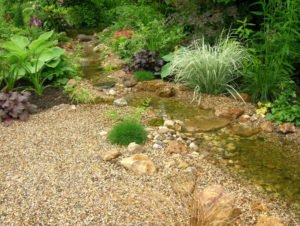

Leave a Reply